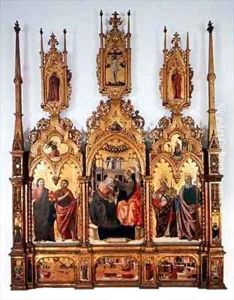Agnolo & Bartolomeo degli Erri Paintings
Agnolo and Bartolomeo degli Erri were Italian painters of the Quattrocento (15th century), active mainly in their native city of Modena, Italy. They were brothers, and their collective work is often associated with the late Gothic and early Renaissance periods. The exact birth and death dates of Bartolomeo are not well-documented, but Agnolo is believed to have been born around 1410 and known to have been active until at least 1482. Little is known about their training and early life, but it is likely that they were part of a family workshop, a common practice of the time.
The degli Erri brothers worked alongside another brother, or possibly a cousin, named Giovanni, and together they formed a productive workshop. Their work includes altarpieces and other religious paintings, characterized by their attention to detail, use of vivid colors, and a blend of traditional Gothic elements with the emerging Renaissance style, particularly the use of perspective and a greater sense of naturalism.
One of their most notable works is a series of panels depicting the life of St. Vincent Ferrer, which they created for the predella of an altarpiece in San Domenico, Modena. Agnolo's individual contributions have also been identified in several other works, such as the 'Madonna and Child' and 'The Annunciation'. The legacy of the degli Erri brothers is significant in the context of the Modenese School of painting, and they are considered among the important precursors to the more widely recognized Renaissance artists who would follow in the later part of the 15th century.
The historical record on the degli Erri brothers is limited, and much of their life and work remain shrouded in mystery. As with many artists of the period, their contributions were often collectively attributed, making it difficult to distinguish between the individual styles and works of the brothers. Nevertheless, their art provides valuable insight into the cultural and artistic transitions that were occurring in Italy during this transformative period.
